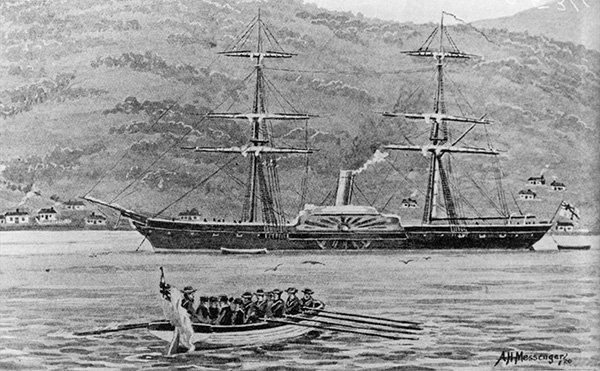Jade River: A History of the Mahurangi
Ronald H LockerFirst published 2001. Published online 2014–. This online edition is a work in progress…
Page 155in printed edition
Steam comes to the Waitematā

Steam Comes to Aotearoa: Steam came to Aotearoa with a vengeance, in the form of hms Driver, which, on her way to becoming the first steamship to circumnavigate the globe, had time to participate in the Hutt Valley Campaign of the New Zealand wars. She entered the Waitematā in 1846. image A H Messenger, from a sketch by Captain M Clayton
In the wider world, the great age of steam was well under way, a product of the inventive spirit of British engineering.
As railways crisscrossed Britain in the 1830s, the first steamships were being built, and were destined to have a profound impact on global navigation. The first practical steamboat had paddled down the Clyde in 1801, and in the year of the Treaty of Waitangi, Brunel’s first screw steamer, Great Britain, was launched. The new technology soon penetrated to the farther colonies. In the 1850s, early steamers brought some of the hopefuls who flocked from England to the diggings of Victoria. There a great tract of the inland was also being opened up by paddle steamers, penetrating ever further into the great Murray–Darling River system.
The first steamship to appear in New Zealand was hms Driver from the Australia station, which arrived on the Waitematā in 1846. Steam was soon seen to be relevant to our pattern of coastal settlement. Its military significance was grasped by General Cameron, whose Waikato campaign of 1863–4 was entirely dependent on the sternwheelers, which could breast the river current and pass its shoals. In his next campaign in Taranaki he was able to provision his bases out of Whanganui by little paddle steamers, which could ‘walk’ over the dangerous bar of the Patea River.
Steamboats were of special interest to the city of Auckland, as the hub of far-flung water settlements, beset on the west coast by evil bars and on the east by winding mangrove creeks. Steamboats offered a better possibility of survival on the one, and of keeping a schedule on the other. Not least, that inconvenient ditch dividing the city cried out for a ferry service. This was soon attempted, but success was elusive. The first steamboat to be built locally was Governor Wynyard, a paddle steamer, launched on the Waitematā in 1851. It was a triumph of local ingenuity, even to the building of the engine. The second was City of Auckland with two engines of 10 horsepower and screws. Both were built with the ferry service in mind, but neither succeeded in its purpose.
One of the first steamboats to enter Mahurangi could have been hms Acheron, during its survey of the Hauraki Gulf at the end of 1851. In 1864, two rigged steam frigates, hms Falcon and Miranda, were operating in the gulf, the former ferrying Sir George Grey between Auckland and Kawau.
